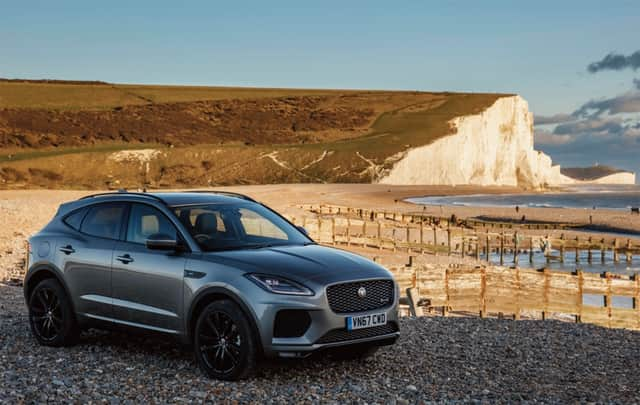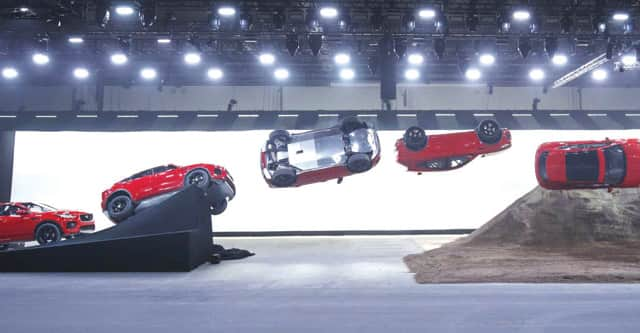MOTORS REVIEW: Jaguar E-Pace


JAGUAR Land Rover is feeling the heat as demand for its flagship premium models is impacted by trade wars with China and a shift away from diesel.
The Tata Automotive-owned brand recently trimmed 1,000 agency staff from its production facility in Solihull and placed its workforce at the Range Rover-producing Castle Bromwich plant on a three-day week.
Advertisement
Hide AdAdvertisement
Hide AdUnfortunately for the UK, two of the iconic British brand’s latest, and most promising new products are now being built overseas.
Arriving in Jaguar dealerships this year, the E-Pace SUV and its pure electric stablemate, the I-Pace, are both being built in Austria and in an overall market which has seen registrations dip 7.5 per cent to the end of September, the £63,495-plus I-Pace EV has succeeded in adding 307 sales so far, the E-Pace 7,653.
Considering that the E-Pace’s early performance in UK showrooms puts it well ahead of the brand’s bread-and-butter executive saloons — the XE with 4,695 sales for far in 2018, and the XF 4,762 — it’s clear that we are going to see a lot more of the Audi Q3, BMW X1 and Volvo XC40 rival.
I tested the 247bhp two-litre turbocharged petrol engine-powered HSE RDynamic (£47,060 basic) to see how the F-Pace’s “baby” sibling will take the battle to its key rivals.
Advertisement
Hide AdAdvertisement
Hide AdThis might be the baby Jaguar SUV — a point reiterated by a small graphic on the base of the windscreen which depicts a prowling Jaguar followed by its cub — but, as the E-Pace is based on the same chassis as the Range Rover Evoque, rather than the aluminium monocoque of the F-Pace, it’s a bit of a heavyweight.
As tested here, it weighs in at 1,832kg, which makes it 150kg heavier than the equivalent XC40 T5 AWD — its closest rival on paper.
The added weight can be felt out on the road, but rather in the way that the E-Pace feels very solid and structurally-sound.
Some drivers will like its robust feel.


Where Jaguar claims that the GKN Driveline “twinster” torque-vectoring rear differential fitted to the more powerful versions of the E-Pace — of which this is one — delivers a typically rear-driven Jaguar dynamics from the AWD drivetrain, this is less the case than in the larger F-Pace.
Advertisement
Hide AdAdvertisement
Hide AdIn the F-Pace, there is a sense that it can be powered out of corners with real oversteering attitude.
In the E-Pace, the set-up feels far more conservative, albeit reflective of others in the class.
Jaguar’s Ingenium two-litre turbocharged petrol engine sounds extremely diesel-like at lower speeds, but delivers numbers worthy of a sporty compact SUV.
The brand claims respectable seven-second acceleration to 62mph and a 143mph top speed, while its eco credentials speak of 36.7mpg fuel economy and 174g/km CO2 emissions.
Advertisement
Hide AdAdvertisement
Hide AdThese figures do fall behind the XC40’s 6.5-second acceleration to 62mph (140mph top speed), and 39.8mpg and 164g/km claims.
On the road, the E-Pace’s engine never feels rampant, but delivers muscular performance on the motorway.
In stop/start traffic, however, I found that the combination of the Ingenium unit with JLR’s latest eight-speed automatic gearbox could produce some occasionally juddery, uncertain progress.
The sporty E-Pace R-Dynamic trim level tested here featured suspension that was firmer than it might be were outright comfort the priority — a characteristic no doubt exacerbated by wheel arch-filling 20-inch alloys — but felt as though it was doing a decent job of curbing the effects of physics on what is a fairly weighty vehicle.
Advertisement
Hide AdAdvertisement
Hide AdR-Dynamic also helps the E-Pace’s design, which features regular cues from the F-Type sports car, to be seen at its best.
A black gloss grille and window surrounds complement that of those big alloys to add a stealthy performance feel.
R-Dynamic stitching features on the sports seats inside, there’s a logo on the base of the fairly large three-spoke steering wheel and neat aluminium brightwork for the pedals and around the F-Type-style gearlever inside.
The E-Pace’s cabin is fairly uncluttered and should be specced carefully to avoid it looking perhaps a little bland and gloomy — away from the impressive 12.3-inch touchscreen of the 360-watt premium infotainment system and five-inch graphic instrument panel of this HSE trim level.
Advertisement
Hide AdAdvertisement
Hide AdA heated windscreen, traffic sign recognition, LED headlights with automated high beam, lane keeping assistance, autonomous emergency braking and autonomous cruise control with queue assist were all present, along with JLR’s All Surface Progress Control off-road assistance.
There was also wifi preparation in my test car that could transform it into a hotspot.
However, fans of the current trend for mirroring smartphone control on infotainment system screens, JLR continues to dispense with the Apple CarPlay or Android Auto systems that make this possible, instead relying on their own in-car operating system.
In many ways, Jaguar’s E-Pace is an accurate downsized reimagining of the FPace which is now the brand’s best-selling vehicle (with 8,940 sales to the end of September).
Advertisement
Hide AdAdvertisement
Hide AdHowever, it lacks its larger sibling’s dynamic prowess and, with the arrival of the Volvo XC40, there is extremely tough competition in this sector.
Given that E-Pace and F-Pace overlap in terms of price — if customers are willing to accept a lesser-equipped or lower-powered version of the latter — pondering a downsize could cause more than a few headaches.
First published Friday, October 19